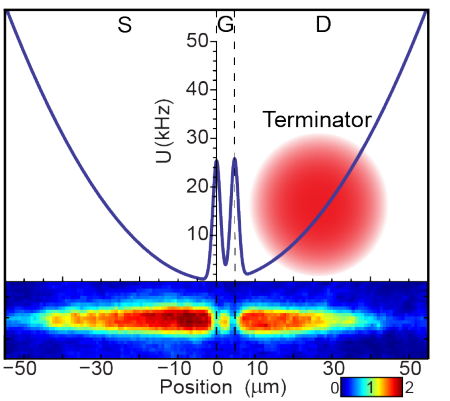First ‘atomtronic’ radio broadcasts matter waves
August 21, 2012

The atomtronic transistor: a hybrid magnetic and optical potential creates the overall confinement of the atomic ensemble as well as a “gate” tunneling junction between “source” and “drain” wells (credit: Seth C. Caliga et al.)
Scientists at the University of Colorado and National Institute for Standards and Technology in Boulder have built a “matterwave oscillator circuit” — one that works with atoms rather than electrons, Technology Review Physics arXiv Blog reports.
The heart of their device is an “atomtronic transistor” — an optomagnetic trap with three compartments that can hold a Bose Einstein Condensate of rubidium atoms cooled almost to absolute zero.
The scientists call these compartments the source, gate and drain (with the gate sandwiched between the source and drain). The optical barrier between the compartments prevents atoms from moving freely between them.
They initiate their atomtronic transistor by filling the source compartment with rubidium atoms. This process is like charging a capacitor: it produces a chemical potential that pushes atoms through the device, just as electric potential drives electrons.
They then lower the barriers to allow atoms to tunnel into the gate; the atoms can tunnel back again, which leads to the oscillation.
The atoms are also able to tunnel from the gate to the drain and out of the device. This is the matter wave emission.
To prevent the atoms tunnelling back again from the drain, the scientists zap this region with a laser beam. This excites the atoms, sending the matter wave out into space. That’s why the device is analogous to an electronic oscillator generating electromagnetic waves in a radio.
Together, this laser and the input of rubidium atoms to the source are like a battery that powers the device.
There are one or two limitations: the device stops working when it runs out of atoms, a number that is limited by the number of atoms in a Bose Einstein Condensate, in this case a few tens of thousands. The only way to fix this is to generate a continuous source of these atoms, something nobody has yet worked out.
However, “the matterwave oscillator may have a significant role to play in the development of atom-based sensors, and perhaps in quantum information processing,” the researchers say.